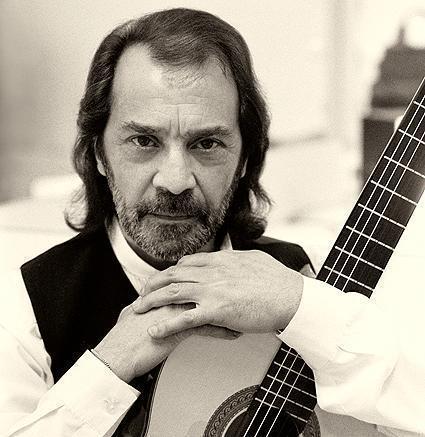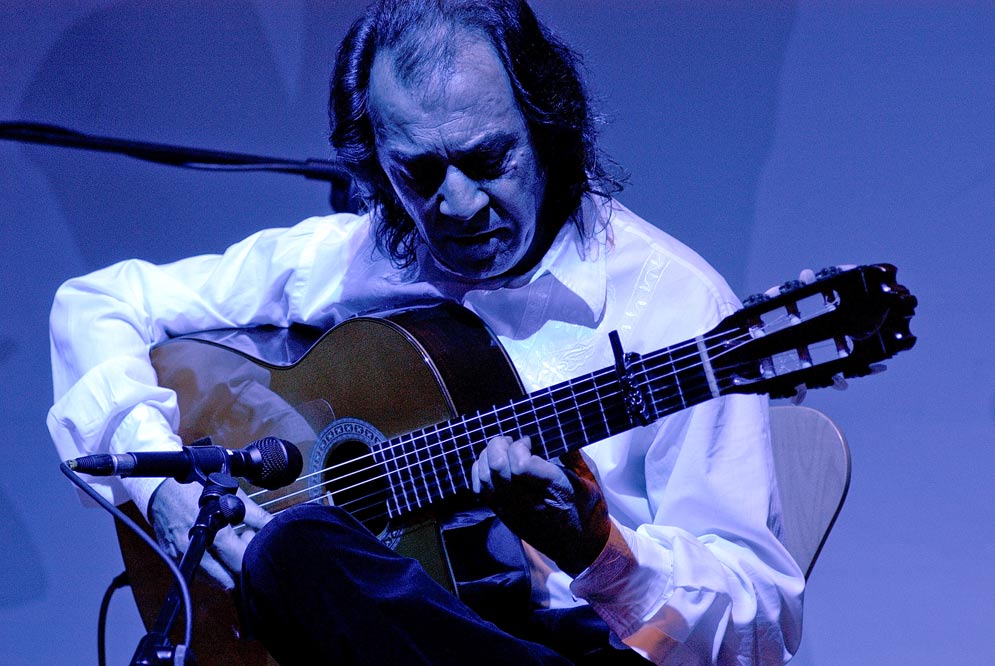<Back to Index>
- Guitarist Mario Escudero Valero Jimenez Valverde, 1928
- Guitarist Pepe Habichuela (José Antonio Carmona Carmona), 1944
PAGE SPONSOR

Mario Escudero, full name Mario Escudero Valero Jimenez Valverde (October 11, 1928 - November 19, 2004), was one of a handful of Spanish flamenco guitar virtuosos who helped spread flamenco beyond their homeland when they migrated to the United States in the early 1950s. After completing his obligatory military service in Spain, he toured with the best known companies of the time, and soon traveled with them to the US as first soloist.
Along with others such as Sabicas, Carlos Montoya and Juan Serrano (Flamenco), Escudero helped forge the viability of solo flamenco guitar as a concert instrument with lauded performances at New York's Carnegie Hall,
Town Hall, and other venues. Invited to perform at the White House for
President Kennedy, Escudero was counted among the best in his era - Ramón Montoya called him "the best flamenco guitarist of this new generation."
Mario Escudero’s family originally came from Navarra, Spain, although they also settled in Huesca and Zaragoza (Aragón), where his father Jesus was born. Mario was an only child. Emigrating to San Sebastian, the family opened and ran a very successful tailor shop close to "La Concha" beach. The breakout of the civil war, however, forced them to emigrate to southern France. While in France, the Escudero family formed a flamenco group with family members and performed with artists like Maurice Chevalier and Mistinguette. His first performance, at the ripe age of 9, was with Maurice Chevalier at the Cinema Galia in Bordeaux, France. In France, he received his first schooling and became fluent in French, as he also did in English later in life.
After the war, the family settled in Madrid, where they lived on a side street off Gran Vía (San Marcos #4). While his first teacher was his father, he took classical guitar and music lessons with Daniel Fortea (a pupil of Francisco Tárrega), and flamenco guitar lessons with Ramón Montoya. Notwithstanding, his influences also include El Niño Ricardo (Manuel Serrapí) and other contemporaries. In 1944, he debuted in Madrid at El Teatro Español with Vicente Escudero and Carmita García. In later years, he expanded his musical training studying harmony and counterpoint with Walter Piston's well known texts, and wrote down most of his best known pieces.
Escudero was of Castilian and gypsy descent, born in Alicante, Spain, on October 11, 1928. His mother was Alfonsa Josefina Valero Valverde (d. 1947, when he was 19), a Spanish singer, native of Villanueva de los Infantes, Ciudad Real (although the family had migrated there from Camas, Sevilla), and his father was Jesus Escudero Jiménez (d. 1965), a gypsy "por los cuatro costados" as it is commonly said in Spain.
He recorded three albums of duets with Sabicas. He also recorded several other recordings with Sabicas, his brother Diego Castellon, Enrique Montoya, Domingo Alvarado. He often performed with flamenco dancer Anita Ramos, who played castanets and zapateados on the recordings, and the two eventually married and had three children.
In fact, Sabicas and Mario Escudero were not only "compadres" (Sabicas was the godfather of one of Mario’s children, Agustín Mario Manuel), but were related through family ties through Jiménez, Carbonell and Gabarre. Both had several common ancestors, the best known being Agustina Escudero Heredia (known as the "Queen of the Gypsies"), married to Benigno García Gabarre, and one of Ignacio Zuloaga's (well know Spanish painter) main models. Agustina was also the mother of the bullfighter Rafael Albaicín and the dancers Miguel and Maria Albaicín.
Praise and standing ovations from critics and public paved the way for more work, with Escudero touring throughout Europe, South America, and eventually the US. His first two solo Carnegie Hall concerts sold out, and garnered acclaim and praise, leading to several television appearances.
Escudero first settled in San Gabriel, California, performing at El Poche while continuing with a busy national and international concert schedule and many recording engagements. Becoming a US citizen in 1969, he was the first flamenco guitarist to tour the Soviet Union (1973) to perform as a flamenco guitar soloist and as a private citizen - the only condition the State owned Gosconcert imposed for the concerts is that he had to perform in the typical "traje corto" outfit (which he did regularly anyway). He was invited again on a second tour in 1979.
In
1965, he established his US residence in New York City
(midtown Manhattan / 58th & 6th Avenue) and his Spanish residence in
the "barrio" Heliopolis where he owned a home. After 1981, he lived
mostly in Sevilla and returned to the US for concert tours and
recordings. In 1994, a victim of acute Alzheimer’s disease, he sought
advanced treatment of this disease in Miami, Florida, where he received
excellent compassionate care. He died on November 19th, 2004 and is
buried in the Cemetery of Fuencarral, Madrid, in the family tomb with
his mother and aunt


Pepe Habichuela (born 1944 as José Antonio Carmona Carmona in Granada ) is a Spanish flamenco guitarist, cited as one of the great flamenco masters and one of Spain's finest contemporary guitarists. He belongs to a flamenco dynasty of gypsies started by his grandfather, known as "Habichuela el Viejo" (Old Bean), who took the nickname, and continued by his father José Carmona and his brothers Juan Habichuela (1933), Carlos and Luis.
In 1964 he moved to Madrid where he performed in several flamenco shows and shared the stage with artists such as Juanito Valderrama, Camarón de la Isla and Enrique Morente. He recorded an album in tribute to singer Antonio Chacón which won the National Prize of discography in 1975.
He is the father of José Miguel Carmona Niño and uncle of Juan José Carmona Amaya El Camborio and Antonio Carmona Amaya (sons of his brother Juan Habichuela). The three formed the New Flamenco band Ketama. In 2001, Habichuela released the album Yerbagüena as part of Pepe Habichuela & The Bollywood Strings, a unique mix of flamenco guitar and Indian string music. He has also experimented with Arabic - flamenco fusion music. Habichuela was a mentor to Adam del Monte. He has been described as "highly emotional" likeTomatito, with one author saying "If flamenco has earned its rep as an overly emotional music, it isn't going to be Habichuela who turns it around."